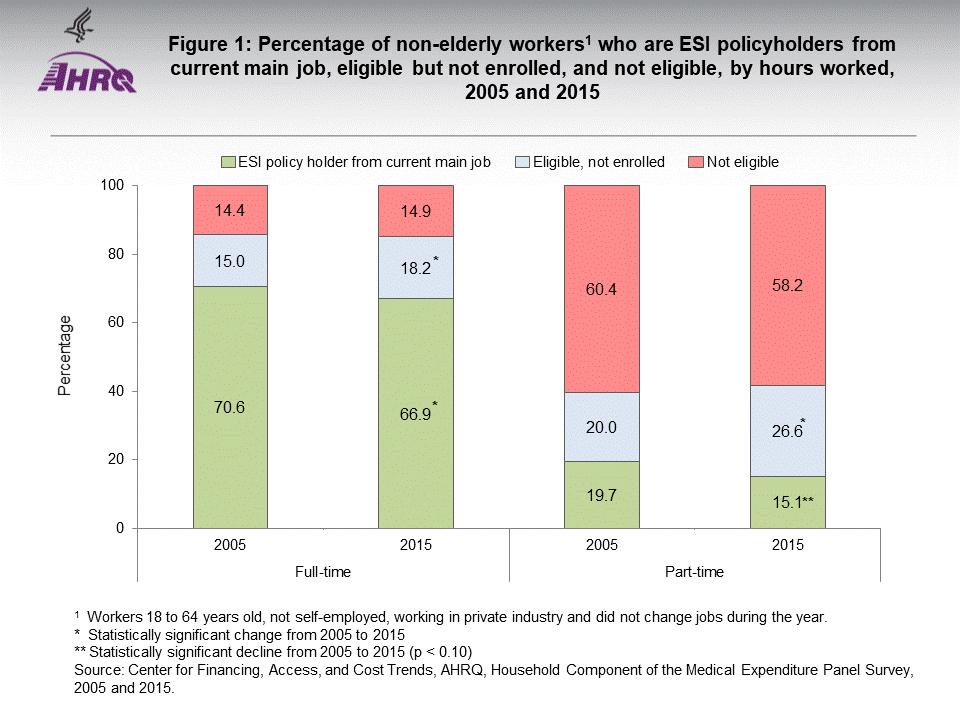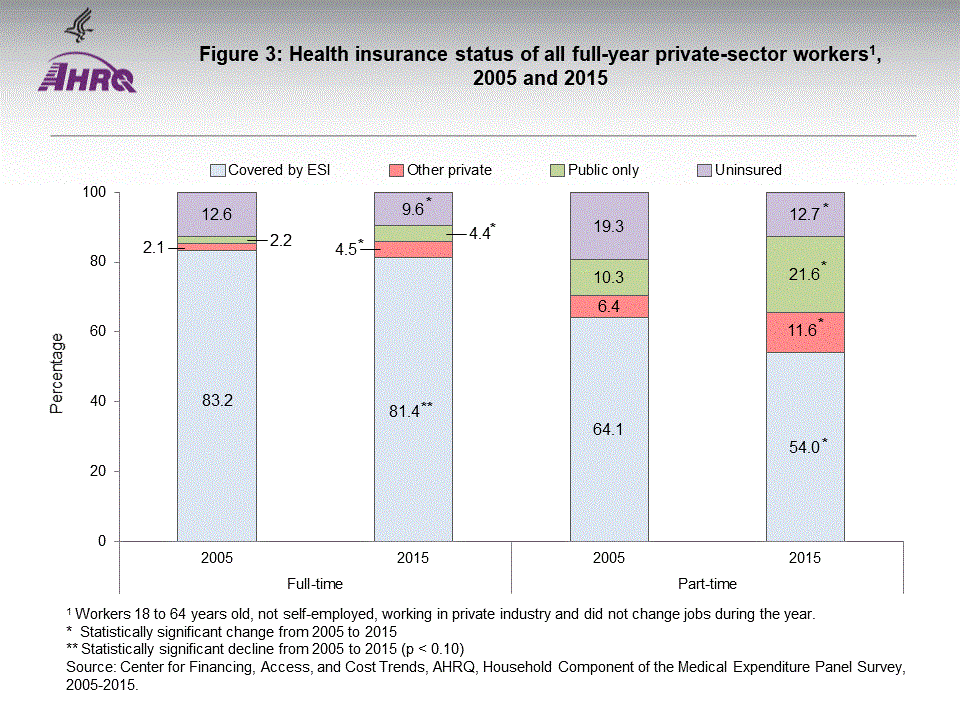Skip to main content
|
||||||||||||||||||||||||||||
|
|
||||||||||||||||||||||||||||
STATISTICAL BRIEF #511:
|
||||||||||||||||||||||||||||
| April 2018 | ||||||||||||||||||||||||||||
|
William A. Carroll, MA and G. Edward Miller, PhD |
||||||||||||||||||||||||||||
Highlights
|
||||||||||||||||||||||||||||
IntroductionEmployer-sponsored insurance (ESI) provided by a current employer continues to be the primary source of health insurance coverage for non-elderly, private-sector workers in the United States. To be covered as an ESI policyholder on a plan provided by their current employer, an individual must work for an employer that offers health insurance, meet the eligibility requirements, and enroll in offered coverage. Workers may also obtain ESI coverage as a dependent on a plan offered to their spouse or other family member, and some workers obtain coverage on an ESI plan provided by a former employer or a secondary job. In addition, workers may obtain coverage through individually purchased private insurance or, if they are eligible, through Medicaid or other public insurance programs. This Statistical Brief uses data from the 2005 and 2015 Medical Expenditure Panel Survey Household Component (MEPS-HC) to examine changes in health insurance coverage of non-elderly adults who worked for the same private-sector employer for the entire year.The availability of ESI coverage for U.S. private-sector employees may vary by a number of employer and workforce characteristics including firm size, industry, wage distribution, and union status. In this Brief, we focus on variation by the number of hours employees work. Specifically, we compare health insurance coverage for employees who work full time (30 or more hours per week) with those who work part time (fewer than 30 hours per week). We begin by examining ESI eligibility and enrollment in plans offered at workers' current main jobs. Then, we examine levels and changes in four hierarchical insurance categories that indicate any coverage during the year: ESI policyholder from current main job, other ESI, other private insurance, and public insurance. The remaining workers are uninsured for the entire year. Only those differences that are statistically significant at the 0.05 level or better are discussed in the text, unless otherwise noted. |
||||||||||||||||||||||||||||
FindingsESI eligibility and enrollment at current main jobAs shown in figure 1, in 2015, full-time workers were more than 4 times as likely as part-time workers to be policyholders of ESI provided through their current main job (66.9 vs. 15.1 percent). Conversely, part-time workers were more than 4 times as likely to not be eligible for ESI (58.2 vs. 14.9 percent) either because they worked at an employer that didn't offer ESI, or because they were ineligible for offered coverage. Part-time workers were also somewhat more likely to be eligible for, but not enrolled in ESI (26.6 vs. 18.2 percent). Differences between full- and part-time workers in ESI eligibility and enrollment were qualitatively similar in 2005. From 2005 to 2015, the percentage of full-time workers who were enrolled in ESI as policyholders at their current main job fell by 3.7 percentage points, from 70.6 to 66.9 percent, while the percentage of part-time workers who were ESI policyholders fell by 4.6 percentage points (p < 0.10), from 19.7 to 15.1 percent. There was no significant change for either group in the percentage of workers who were not eligible for coverage. Instead, the reduction in ESI policyholders was primarily due to reduced take-up of offered insurance as the percentage of full-time workers who were eligible for, but not enrolled in, ESI increased by 3.2 percentage points (from 15.0 to 18.2 percent), and the percentage of part-time workers who were eligible but not enrolled increased by 6.6 percentage points (from 20.0 to 26.6 percent). Other ESI coverage Figure 2 presents estimates of the percentages of full-time and part-time workers that had ESI coverage from any source. The "other ESI" category includes workers who were covered as a dependent on an ESI plan held by a spouse or other family member, as well as a small percentage of workers who were covered by a plan provided by a former employer or a secondary job. Results highlight the greater importance of ESI dependent coverage for part-time workers than for full-time workers. In 2015, part-time workers were more than 2 times as likely as full-time workers to have other ESI coverage (38.9 vs. 14.5 percent) and other ESI coverage accounted for nearly three-quarters (72.0 percent) of all ESI coverage held by part-time workers. By contrast, other ESI coverage accounted for approximately one-fifth (17.8 percent) of all ESI coverage held by full-time workers. These patterns were qualitatively similar in 2005. Insurance status of all workers Figure 3 shows the health insurance status (across all sources of insurance) for all workers who worked at the same job for the entire year. In 2005, full-time workers were more likely than part-time workers to be covered by ESI (83.2 vs. 64.1 percent), less likely to be covered by other private insurance (2.1 vs. 6.4 percent) or public insurance (2.2 vs. 10.3 percent), and less likely to be uninsured (12.6 vs. 19.3 percent). From 2005 to 2015, the percentage of workers covered by ESI decreased for all workers regardless of hours worked. Full-time workers had a small but statistically significant decrease in the percentage who were covered by ESI of 1.8 percentage points (p < 0.10) (from 83.2 to 81.4 percent) while the percentage of part-time workers covered by ESI decreased by 10.1 percentage points (from 64.1 to 54.0 percent). The percentage of workers with other private insurance (which included Marketplace coverage in 2015) increased by 2.4 percentage points for full-time workers, while the percentage for part-time workers increased by 5.2 percentage points between 2005 and 2015. The percentage with public coverage increased by 2.2 percentage points for full-time workers (from 2.2 to 4.4 percent) and increased by 11.3 percentage points for part-time workers (from 10.3 to 21.6 percent). Both groups of workers had a significant decline in the percentage uninsured, with full-time workers dropping 3.0 percentage points (from 12.6 to 9.6 percent) and part-time workers dropping 6.6 percentage points (from 19.3 to 12.7 percent). By 2015, full-time workers were still more likely than part-time workers to be covered by ESI (81.4 vs. 54.0 percent), less likely to be covered by other private insurance (4.5 vs. 11.6 percent) or public insurance (4.4 vs. 21.6 percent), and less likely to be uninsured (9.6 vs. 12.7 percent). |
||||||||||||||||||||||||||||
Data SourceThis Statistical Brief uses data from the 2005 and 2015 MEPS Full Year Consolidated Data Files (HC-097 and HC-181) and the 2000-2013 Employment Variables File (HC-131). |
||||||||||||||||||||||||||||
DefinitionsFull-year employeesIn this Brief, full-year employees are non-elderly adults (ages 18-64) who reported that: 1) they had a job at the time of the round 3/1, round 4/2, and round 5/3 interview dates; 2) they were wage earners (i.e., they were not self-employed); 3) their job was in the private sector; and 4) they did not change jobs during the year. Private sector The private sector refers to all economic activity other than that of U.S. federal, state, or local governments. In the MEPS-HC, the category of "private-sector workers" includes individuals who worked for foreign governments. Full-time/part-time status Full-time workers are those who worked 30 or more hours per week in round 3/1, while part-time workers are those who worked fewer than 30 hours per week in round 3/1. Since this Brief only includes individuals who held the same job for the entire year, full-time/part-time status rarely changes across rounds. Health insurance definitions In this Brief, we use the following hierarchical insurance categories that indicate any coverage during the survey year:
To be eligible for ESI, a worker must work for an employer that offers ESI and they must be eligible for the offered coverage. |
||||||||||||||||||||||||||||
About MEPS-HCMEPS-HC is a nationally representative longitudinal survey that collects detailed information on health care utilization and expenditures, health insurance, and health status, as well as a wide variety of social, demographic, and economic characteristics for the U.S. civilian noninstitutionalized population. It is cosponsored by the Agency for Healthcare Research and Quality and the National Center for Health Statistics.For more information about MEPS, call the MEPS information coordinator at AHRQ (301-427-1406) or visit the MEPS Web site at https://meps.ahrq.gov/mepsweb/index.jsp. |
||||||||||||||||||||||||||||
ReferencesFor a detailed description of the MEPS-HC survey design, sample design, and methods used to minimize sources of nonsampling error, see the following publications:Cohen, J. Design and Methods of the Medical Expenditure Panel Survey Household Component. MEPS Methodology Report No. 1. AHCPR Pub. No. 97-0026. Rockville, MD: Agency for Health Care Policy and Research, 1997. https://meps.ahrq.gov/data_files/publications/mr1/mr1.shtml. Cohen, S. Sample Design of the 1996 Medical Expenditure Panel Survey Household Component. MEPS Methodology Report No. 2. AHCPR Pub. No. 97-0027. Rockville, MD: Agency for Health Care Policy and Research, 1997. https://meps.ahrq.gov/data_files/publications/mr2/mr2.shtml. |
||||||||||||||||||||||||||||
Suggested CitationCarroll, W.A. and Miller, G.E. Differences in Health Insurance Coverage between Part-Time and Full-Time Private-Sector Workers, 2005 and 2015. Statistical Brief #511. April 2018. Agency for Healthcare Research and Quality, Rockville, MD. https://meps.ahrq.gov/mepsweb/data_files/publications/st511/stat511.shtml |
||||||||||||||||||||||||||||
|
AHRQ welcomes questions and comments from readers of this publication who are interested in obtaining more information about access, cost, use, financing, and quality of health care in the United States. We also invite you to tell us how you are using this Statistical Brief and other MEPS data and tools and to share suggestions on how MEPS products might be enhanced to further meet your needs. Please email us at MEPSProjectDirector@ahrq.hhs.gov or send a letter to the address below: Joel Cohen, PhD, Director Center for Financing, Access, and Cost Trends Agency for Healthcare Research and Quality 5600 Fishers Lane, Mailstop 07W41A Rockville, MD 20857 |
||||||||||||||||||||||||||||
 |
||||||||||||||||||||||||||||
1 Workers 18 to 64 years old, not self-employed, working in private industry and did not change jobs during the year. |
||||||||||||||||||||||||||||
 |
||||||||||||||||||||||||||||
1 Workers 18 to 64 years old, not self-employed, working in private industry and did not change jobs during the year. |
||||||||||||||||||||||||||||
 |
||||||||||||||||||||||||||||
1Workers 18 to 64 years old, not self-employed, working in private industry and did not change jobs during the year. |
||||||||||||||||||||||||||||
|
| ||||||||||||||||||||||||||||



